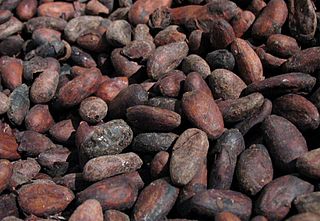
Neapolitan ice cream, also sometimes referred to as Harlequin ice cream, is an ice cream composed of three separate flavors arranged side by side in the same container, usually without any barrier between them.

Chartreuse is a French herbal liqueur available in green and yellow versions that differ in taste and alcohol content. The liqueur has been made by Carthusian monks since 1737 according to instructions set out in a manuscript given to them by François Annibal d'Estrées in 1605. It was named after the monks' Grande Chartreuse monastery, located in the Chartreuse Mountains north of Grenoble. Today the liqueur is produced in their distillery in nearby Aiguenoire. It is composed of distilled alcohol aged with 130 herbs, plants and flowers.

Grand Marnier is a French brand of liqueurs. The brand's best-known product is Grand Marnier Cordon Rouge, an orange-flavored liqueur created in 1880 by Alexandre Marnier-Lapostolle. It is made from a blend of Cognac brandy, distilled essence of bitter orange, and sugar, containing 40% alcohol. It is commonly consumed "neat" as a cordial or a digestif, and can be used in mixed drinks and desserts. Popular examples of the latter include crêpes Suzette and crêpes au Grand Marnier.

Crème de Noyaux is an almond-flavored crème liqueur, although it is actually made from apricot kernels or the kernels of peach or cherry pits, which provide an almond-like flavor. Both Bols and Hiram Walker produce artificially colored red versions of the liqueur while Noyau de Poissy from France is available in both clear (blanc) and barrel-aged amber (ambre) versions.

Ratafia is a broad term used for two types of sweet alcoholic beverages, a flavouring essence whose taste resembles bitter almonds, later to a ratafia flavoured biscuit, a biscuit to be eaten along with ratafia, and later still, to a cherry variety.
Limoncello is an Italian lemon liqueur mainly produced in southern Italy, especially in the region around the Gulf of Naples, the Amalfi Coast and Sicily. It is the second-most popular liqueur in Italy and is traditionally served chilled as an after-dinner digestif. It is also a popular homemade liqueur, with various recipes available online and in print.

Bénédictine is a herbal liqueur produced in France. It was developed by wine merchant Alexandre Le Grand in the 19th century, and is flavored with twenty-seven flowers, berries, herbs, roots, and spices.

Centerbe or Centerba is a liqueur made by aromatic herbs commonly found on Mount Majella. It is a typical Abruzzese liquor in central Italy and is made on a base of 70% alcohol. The liqueur comes in two strengths: strong and mild. The strong centerba is widely used as digestif after-meals and has antiseptic properties. It was originally manufactured by Beniamino Toro in Tocco da Casauria in 1817.

Chocolate liqueur is a chocolate-flavored liqueur made from a base liquor of whisky or vodka. Unlike chocolate liquor, chocolate liqueur contains alcohol. Chocolate liqueur is often used as an ingredient in mixology, baking, and cooking.
Nocello is a walnut flavored liqueur from Italy. It is produced by the Toschi Vignola S.r.l. company of Savignano sul Panaro, province of Modena, Emilia-Romagna, Italy. The product originated in Emilia-Romagna. It is labeled "Imitation Liqueur" in the United States and is 24% alcohol by volume. The liqueur is sweet with a rounded and balanced walnut flavour with vanilla tones. Nocello is similar in taste to Frangelico. In 2004 Nocello was awarded a gold medal at the IWSC competition for nut liquors. Similar liqueurs have "been produced since medieval times and used as medicine".
Flavored liquors are liquors that have added flavoring and, in some cases, a small amount of added sugar. They are distinct from liqueurs in that liqueurs have a high sugar content and may also contain glycerine.

A shooter, or shot, is a small serving of spirits or a mixed drink, typically consumed quickly, often in a single gulp. It is common to serve a shooter as a side to a larger drink.
Lucas Bols N.V. is a Dutch public company in the business of production, distribution, sales and marketing of alcoholic beverages. It claims to be the oldest distillery brand in the world. Its brand portfolio consists of Bols, Galliano, Vaccari, Pisang Ambon, Gold Strike and a large group of Dutch genevers and liqueurs. It produces about 3 million cases a year, with yearly revenues exceeding 95 million euros.
Maple liqueur refers to various alcoholic products made from maple syrup, primarily in the Northeast United States and Canada. It is most commonly made by mixing Canadian rye whiskey and Canadian maple syrup. Maple liqueur is considered an important cultural beverage in certain Canadian festivals.

Watershed Distillery is a microdistillery in Columbus, Ohio, United States, founded in 2010 by business partners Greg Lehman and Dave Rigo. The distillery was the second distillery opened in Central Ohio after prohibition, and Watershed brought to market the first legally distilled bourbon whiskey in Central Ohio post-prohibition in 2012. The distillery offers tours to the public and was the first distillery in Ohio to open a restaurant on-site in February 2017, following the passage of Ohio House Bill 351 in 2016. The distillery offers six spirits: vodka, two types of American style gin, bourbon, nocino and a bottled Old Fashioned cocktail.
Takumi's aviation is a modern classic cocktail made with gin, maraschino liqueur, parfait d'amour, and lemon juice. It is served straight up, in a cocktail glass.










